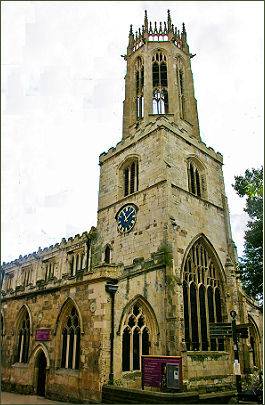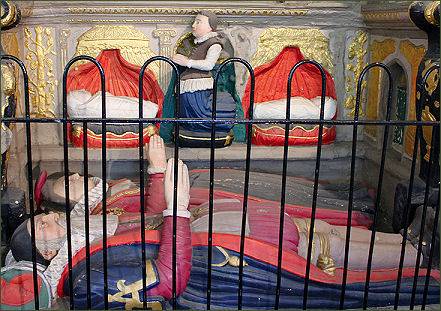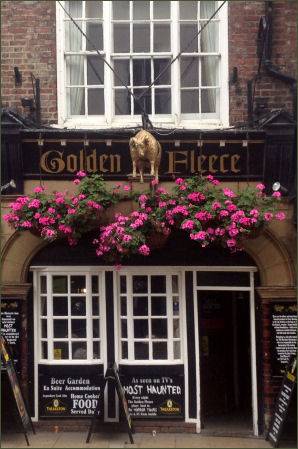Pavement, York
 Pavement acquired its name in 1378, which derives from the fact of all the medieval streets of York, it was the first to be paved.
Pavement acquired its name in 1378, which derives from the fact of all the medieval streets of York, it was the first to be paved.
 Know previously as Marketshire, it was one of the two general markets in the city and a place were announcements and public punishments were carried out.
Know previously as Marketshire, it was one of the two general markets in the city and a place were announcements and public punishments were carried out.
One of the most famous of these was the beheading of Thomas Percy, Earl of Northumberland who was executed on a scaffolding on Pavement on 22nd August 1572 for treason, due to his part in the failed Rising of the North, a Catholic rebellion against Queen Elizabeth I. His head was impaled on a spike at Micklegate Bar while his headless body was buried at the now demolished St Crux church.
The street once housed two churches. All Saints (pictured left) , built in the fourteenth century, which still stands today where Pavement forks into Coppergate and High Ousegate.
The earliest mention of a church on this site is found in the Domesday Survey of 1086. An Anglo-Saxon grave cover, which dates from the tenth century, provides the earliest evidence for a burial ground.
All Saints, a Grade I listed building, is the Guild and Civic church of York. It is also the Regimental church of the Royal Dragoon Guards. The lantern tower was build to house a lamp to act as a beacon for travelers in the Forest of Galtres to the north of the city.
The church retains many interesting features inside including the City council pew, the pulpit which dates from 1634 from which John Wesley preached during a visit to York. Saxon and Viking tombstones can also be seen inside the church. The stained glass is from three different periods. The passion window at the west end dates from fourteenth century and is unique. There are four nineteenth century windows by Charles Kempe and one modern window installed in 2002 for the Royal Dragoon Guards.The building was restored after the First World War to act as the church's war memorial.
 The other church on Pavement, St Crux, once the largest parish church in York, the brick tower, which was added in 1667, was described by Francis Drake in 1736 as 'a handsome new steeple of brick coined with stone'.
The other church on Pavement, St Crux, once the largest parish church in York, the brick tower, which was added in 1667, was described by Francis Drake in 1736 as 'a handsome new steeple of brick coined with stone'.
The building was declared unsafe in 1881 and after attempts to raise sufficient funds to rebuild it were unsuccessful, it was demolished and replaced with St. Crux Parish Hall, which still remains on the site and is currently used as a café. The hall contains a number of monuments from the old church (pictured above right). Part of the stone wall of the fifteenth-century north aisle is still visible, and forms part of the southern exterior wall of no. 23 the Shambles. The name is a corruption of 'Saincte Crusses' which means Holy Cross.
The fine, large black and white half timbered building on Pavement was the birthplace to Sir Thomas Herbert Bart, 1st Baronet. It stands on the site of a house once belonging to Christopher Herbert, who was a wealthy merchant and a Lord Mayor of London.
Fragmentary wall-paintings were discovered during a restoration of the building in what is supposed to have been the Banqueting Room. The plaque displayed on the first storey of the building notes Sir Thomas Herbert's date of birth of 1606 and beneath it is a Snickelway leading to Lady Peckett's Yard.
The Golden Fleece (pictured right) is York's second oldest pub,it is believed to have been named for gild members of the nearby Merchant Adventurers' Hall who used to frequent the pub. The building is mentioned in the York Archives as far back as 1503, it stands directly opposite York's most picturesque street the Shambles. The rear yard is named after Lady Alice Peckett whose husband, John, owned the premises as well as being Lord Mayor of York around 1702.
The Golden Fleece has a reputation of being the most haunted pub in the country. Many guests have reported seeing the late Lady Peckett wandering the endless corridors and staircases, hers is just one of the five resident spirits purported to haunt the building. There is also said to be a ghost named "One Eyed Jack", a man dressed in a sixteenth-seventeenth century red coat, armed with a pistol, and a Victorian boy who was trampled to death by horses frequents the upper room. The most recent ghost appears to be a Canadian airman who fell to his death from an upper window during the Second World War. There have also been Roman soldiers reported in the cellars!
Guide to the Streets of York
| Coney Street | Coppergate | Fossgate | Goodramgate |
| Minster Close | Pavement | Petergate | The Shambles |
| Snickelways of York | Stonegate |
